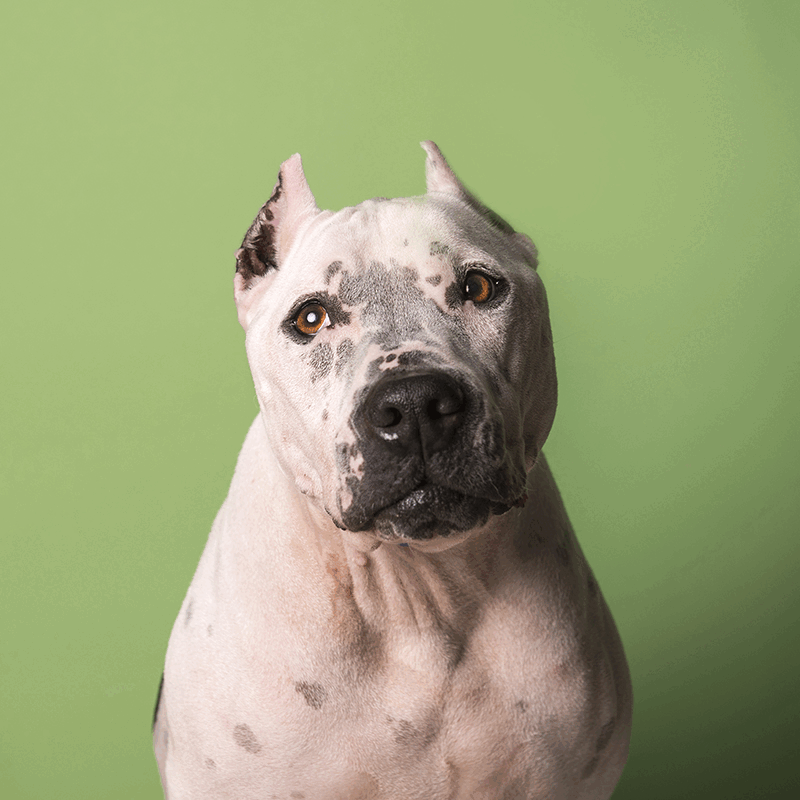These shelter dogs got their ears back thanks to Artificial Intelligence
Using DALL·E 2, I prompted Artificial Intelligence to rebuild some of my models’ ears. All the dogs featured in these photographs are shelter dogs who came to the shelter with their ears cropped. It is unknown what motivated the original owners to crop their dogs’ ears in the first place.
WHAT IS EAR CROPPING?
Ear cropping is the cutting of the external flaps of dogs’ ears. It is done during puppyhood at about eight to twelve weeks old while the ear cartilage is not fully developed, and normally performed under anesthesia by licensed veterinarians.
It is not uncommon for people to crop their dog’s ears at home themselves, sometimes not using professional tools or anesthetics. In 2020, Amazon was still selling “bully breed at-home ear cropping kits”, until a petition pressured them to remove the kits from their listings. Still, it’s very easy to find online guides and still buy those kits, and people have reportedly used knives or scissors to perform the ablation. The top search result I found while googling this issue, instructed, among other steps: “Use the scalpel or kitchen knife and carefully trim the “unwanted” part of the ear. Hold the ear with the forceps during the procedure.” (1)
REASONS BEHIND EAR CROPPING
One of the top reasons people crop their dogs’ ears, is because they are under the impression that it will prevent ear infections. This has not been proven. More often than not, ear infections are linked to environment, hygiene, allergies or even genetic predispositions, and have little/nothing to do with the flaps of the ear. A 2020 study listed allergy as the top cause of otitis in the group of purebred and mixed dogs they observed. (2) Followed by masses, endocrine disease and autoimmune disease. As a matter of fact, Poodles or Cocker Spaniels appear to be the most prone to ear infections, yet they are not traditionally cropped. And though some attribute the infections to their heavy, hairy ears, studies have found ear infections in Cocker Spaniels are likely linked to genetic traits. (3)
Another argument is to prevent ear injury, particularly with working dogs. But this argument seems weak considering most working dogs have intact ears, and injuries, though they do happen, seem fairly uncommon. Moreover, most dogs today are pets and not working dogs.
Ear cropping is often done on so-called guarding breeds purely for looks. The idea is to give a menacing “erect” look to the dog. It is rooted in traditions of blood sports such as bull-baiting and bear-baiting. There are various types of crops: the Long crop, the Show Crop, the Short Crop and the shortest one called the “Battle crop”, where the ears are cropped very close to the skull, which can lead to serious health issues. The battle crop is routinely seen on dogs who end up in rescue. The ear canals are exposed to the elements and debris, and these dogs may suffer ear infections because of this.
Blinx (now Peanut) was rescued in New York. Before he came to the rescue, his previous owner had Peanut’s ears cropped very short, for reasons unknown. His adopter, Heather, notices that Peanut gets a lot of ear infections - which could be linked to his allergies -, but especially after water may have gotten into them, like on a rainy day. The scars where the ear flaps used to be are very sensitive, and can bleed when Peanut scratches them too hard. “I also wonder sometimes if he has difficulty with sound location. There are times when he perks up at a sound but looks in what is obviously the wrong direction, or looks around.” “When I saw the ear reconstruction, I found myself suddenly, unexpectedly in tears! It compounded my existing sadness about Peanut’s ears. I often think about them and imagine what could have been.”
WHAT DO VETERINARIANS THINK OF EAR CROPPING?
Unless done for rare medical reasons, veterinarians around the world agree that ear cropping is an unnecessary procedure, done for cosmetic reasons, and which can lead to short- and long-term problems for the dog. An increasing number of veterinarians are now refusing to perform the procedure when it is not medically justified.
Ear cropping is banned in many countries where it is considered an act of cruelty – most of Europe, the UK, Scandinavian countries, Australia, New Zealand, and parts of Canada have banned the procedure already. In North America, the practice is legal and still very common, despite organizations like the AVMA clearly opposing it.
According to the AVMA (American Veterinary Medical Association), “Many veterinary organizations, in addition to the AVMA, oppose cosmetic cropping including the American Animal Hospital Association (AAHA), Canadian Veterinary Medical Association (CVMA) and Australian Veterinary Association. Individual veterinarians differ in their perspectives”.
The AVMA conducted a literary review and found that (4) “Ear cropping is a cosmetic procedure with potential negative outcomes for the animal.”
WHAT ABOUT BREED STANDARDS?
In the United States, breeders and dog owners continue to cut off their puppies’ ears, sometimes following breed standards but not always. For example, the Staffordshire Terrier’s (5) or the Cane Corso’s (6) breed standards (two breeds that are often cropped), do not call for cropped ears, and leave the option up to the breeder. But the Doberman’s breed standards (7) does call for cropped ears.
Although cropping is not always prescribed by breed standards, it is recognized by breeders as an important trait of many breeds. The American Kennel Club’s position on the matter is unequivocal (8): “The American Kennel Club recognizes that ear cropping, tail docking, and dewclaw removal, as described in certain breed standards, are acceptable practices integral to defining and preserving breed character and/or enhancing good health. (…) Mislabeling these procedures as “cosmetic” is a severe mischaracterization that connotes a lack of respect and knowledge of history and the function of purebred dogs.”
Breeders’ main argument is that some breeds have had their ears cropped for centuries or decades, therefore we must continue (“preserve”) the tradition/look. This, they find, is particularly important for breeds viewed as working or guarding breeds. They fail to acknowledge that most dogs are not working dogs, but rather pets living safe, comfortable lives in their owner’s home. Same goes for tail docking. Did you know that, for example, most Corgis are born with glorious, fluffy tails, which are docked in puppyhood? This is because originally, Corgis were herding cattle, and owners felt their tail could suffer injuries on the job. Today, preservation breeders continue to dock Corgis’ tails to adhere to these old standards, even though most Corgis are pets who will never see a cow in their lives.
Another surprising argument I have heard when speaking with breeders who crop their dogs’ ears, is that the ancestor of the dog we know today, tens of thousands of years ago, had erect ears, and that floppy ears are not natural, and only happen through domestication. Therefore, cropping ears is akin to reverting to a more natural look for dogs. What they fail to consider, is that there is a major difference between a dog born with erect ears, and for which nature will have likely provided thick hair or other natural barriers protecting the ear canal, and dogs born with floppy ears that are now removed surgically, exposing the ear canal to rain, debris and other things. There is a major difference between slow, natural evolution, and hasty surgery / artificial selection.
THE RISKS FOR THE DOG
Ear cropping, like any surgery, can go awfully wrong. Recovery can be particularly tricky and traumatic and can take months. The final shape of the ears is not guaranteed.
The AVMA lists several types of medical/welfare risks for the procedure itself:
“General anesthesia—Cropping should always be carried out under full anesthesia, which itself has associated risks.
Postoperative Care—Dogs will experience some discomfort during healing, stretching, re-taping and bandaging, and other manipulations after surgery. Some will need their ears bandaged or taped upright for days to months, and they may be isolated from other dogs during this period.
Potential Complications—As for any incision, cropped ears may become infected. Cropped ears may also fail to stand or have a distorted shape or position potentially leading to subsequent operations.”
Beyond the surgery, dogs may suffer long-term effects. Even if the puppy recovers well from the gruesome surgery and postoperative care, they might still experience lifelong issues, some of which we might not be fully aware of. For all we know, it is possible dogs suffer from phantom pain as well. Some owners have noticed their dogs being more sensitive to the cold or the wind, for example. This isn’t a far-fetched idea, given that the tip of the ear is now a permanent, probably sensitive scar.
Perhaps the cruelest aspect of ear cropping, is that it robs dogs of one of their most important communication tools. Dogs need their ears - flaps included if they are born with them - for a variety of reasons. The flaps help gather more information: moving their ears in the direction of a sound, using the 18 muscles dogs have in their ears, dogs capture more information and use their flaps to funnel sounds into the ear canal. Dogs also use their ears and flaps to emote and communicate with other dogs, and with humans (9). With their ears, dogs communicate whether they are nervous, alert, relaxed, reactive, enticed... It’s an important tool for them to express appeasement for example. They will flatten their ears backward, tight against their head to signal to others that they wish to de-escalate a stressful situation, or tell the other guy “Hey, I am a friend and want no trouble!” This motion is impossible if the ears are cropped, especially if they’ve been healed in an erect position. An erect ear might actually signal the wrong message to other dogs.
Dogs use their ears to signal to others what their feelings or intentions might be. Dogs today do not live like their ancestors did. Many dogs have intricate and complex social lives, meeting dogs during their walks and at the dog park, living in humans’ homes and having to contend with children, and more. Robbing dogs of their ears as a communication tool could lead them to feel powerless, and perhaps more inclined to escalate, barking or mouthing, when their attempts at expressing themselves more peacefully and subtly are ignored.
Sources:
(1) How to crop dog ears at home: https://healthyhomemadedogtreats.com/how-to-crop-dog-ears-at-home/
(2) Paterson, S., and W. Matyskiewicz. A Study To Evaluate The Primary Causes Associated With Pseudomonas Otitis In 60 Dogs. 2020. https://pubmed.ncbi.nlm.nih.gov/29322531/
(3) https://www.avma.org/about/ear-cropping-and-canine-otitis-externa-faq
(4) AVMA’s Literary review: https://www.avma.org/resources-tools/literature-reviews/welfare-implications-ear-cropping-dogs
(5) American Staffordshire Terrier Breed Standards: https://www.akc.org/dog-breeds/american-staffordshire-terrier/
(6) Cane Corso breed standards: https://www.akc.org/dog-breeds/cane-corso/
(7) Doberman breed standards: https://www.akc.org/dog-breeds/doberman-pinscher/
(8) AKC’s official statement on ear cropping: https://www.akc.org/press-releases/akc-statement-on-avma-crop-and-dock-policy/
(9) Siniscalchi M, D’Ingeo S, Minunno M, Quaranta A. Communication in Dogs. Animals. 2018; 8(8):131. https://www.mdpi.com/2076-2615/8/8/131#B10-animals-08-00131


















